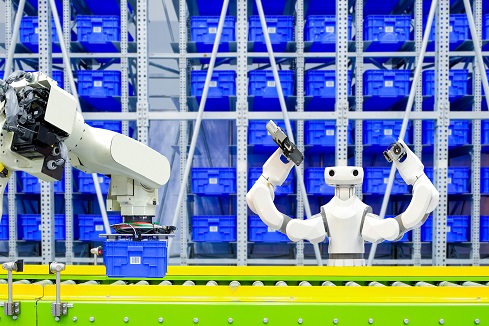
More people are needed for blue collar jobs in areas where AI-enabled automation was to have the most impact. So where are the robots?
Every business sector has been experiencing changes in work due to AI. But just how much change, and how fast, is still up for debate, and new voices are weighing in to suggest that the future is still unwritten when it comes to jobs and automation.
In a recent MIT Sloan article — “Where Are the Robots?” — the authors suggest that robot encroachment into the workplace and the associated worries about AI and automation eliminating jobs are overblown. They point to slow gains in productivity in recent years to suggest that the technologies have not had much impact. Added to this, they discuss the growing demand for blue collar workers over the last several years — the group thought to be most impacted by robotic automation. Are they right, that traditional work roles will not see significant disruption from automation?
In the short-term, possibly so. There are multiple reasons for this, not the least of which is the surge in e-commerce. The authors note that from 2013 to 2018, for example, employment in the transportation and warehousing industries soared by over 20%, compared with 9% across the total economy. This is reinforced by Amazon’s recent news that they are looking to hire 100,000 new full-time and part-time positions for its warehouses and delivery network.
We all see the endless fleet of vans delivering goods from warehouses that are sprouting across the world. Though these jobs are prime functions for automation, the autonomous vehicles and warehouse picking machines are not yet ready for prime time and haven’t arrived in force. Though the strength of the job numbers in these fields might be a short-term blip owing mostly to timing and circumstance, projections are for warehouse employment to continue growing by 21% between 2016 and 2026.
But that’s not to say the robots are not already having an impact.
It is not only the improvement in the physical robots that could eventually lead to displacing workers. Software “robots” in the form of workplace management systems are growing in sophistication and number. For example, workers in call centers are monitored with AI tools for how — and how fast — they answer questions. It’s not only call centers as these systems watch and direct workers in a variety of roles and industries across hospitality, manufacturing, warehousing and grocery. The technology is positioned as an aid to digital transformation, driving improvements in productivity, quality and traceability.
The emergence of cheap sensors and cameras, networks, and AI has also allowed these systems to take on a more detailed supervisory role. By collecting data and analyzing work steps and processes, these tools are laying the groundwork for further automation of various functions eventually leading to “extreme automation.” And it is not only blue collar professions that are seeing this development as robotic automation is making penetration in a wide range of professions from engineering to software development.
When will the robots arrive in force?
In 1961, AI pioneer Marvin Minsky proclaimed, “We are on the threshold of an era that will be strongly influenced, and quite possibly dominated, by intelligent problem-solving machines.” He thought that would happen within a few decades. We are still waiting for this to be fully achieved. The robot invasion has perhaps been delayed but is only a matter of time. For example, more warehouses are adopting robotics technology. The market for warehouse robotics is expected to grow to more than $5 billion in value by 2023, up from $2.4 billion in 2017.
If indeed e-commerce is bolstering warehousing jobs, there is concomitant drive to replace those workers with robots. Machines are increasingly being used to box up customer orders. Picking up an item — the most common warehouse task — is still performed by humans though perhaps not for long as new developments are forthcoming. Grasping robots could then replace those workers and then warehouses might be nearly autonomous.
A study from PwC describes three overlapping cycles of automation that will stretch into the 2030s, each with their own degree of job impact. These are the algorithm wave, the augmentation wave and the autonomy wave. According to the study, only around 3% of jobs are at high risk for automation from the algorithm wave by the early 2020s, but this rises to almost 20% by the late 2020s from the augmentation wave, and around 30% by the mid-2030s. It is that late 2020s wave that will bring the robots to warehouses and semi-autonomous vehicles to transportation. This is echoed by Forrester vice president and principal consultant Huard Smith who claims 38% of location-based jobs will be automated by 2030.
Nothing new under the sun
This focus on efficiency, ever faster and better, is just one more step in a trend that’s been going on for more than a century. This started in earnest with “scientific management” of workers led by Frederick Taylor near the turn of the twentieth century, with “time and motion” studies to determine the optimal way to perform a job. Through this, business management focused on maximizing control over how people performed work.
Digital technologies including AI-enabled computer vision, IoT sensor arrays and pervasive connectivity has led to a new generation of time and motion studies based on large data sets and using advanced analytics. For example, Denso, an automotive components manufacturer, is working with Drishti Technologies at several North American factories to identify bottlenecks and provide feedback in real time to optimize production. An executive at Denso said, “We want to make sure quality is top-notch, but an industrial engineer standing behind an associate with a stopwatch skews the data. It’s just a snapshot, and assembly is a dynamic process.”
Some claim that “digital workers”– a euphemism for software robots — make work more exciting and interesting for humans. Sometimes this interest is simply through gamification, to add a beat and rhythm to what can otherwise be monotonous work. Amazon, for example, uses Mission Racer, a video game that pits workers against one another to assemble customer orders fastest. The faster a worker picks items and puts them into a box, the faster their car will navigate through a virtual track in the game.
Fun aside, a report from the U.C. Berkeley Labor Center states that algorithmic management introduces new forms of workplace control, where the technological regulation of workers’ performance is granular, scalable, and relentless. This can lead to micromanagement of work tasks at an unprecedented scale.
However, people naturally resist being told how to work, even more so when the method is compulsory. Humans are still more dexterous and flexible than robots, but that will change over time. The idea of robots taking over, arguably by late this decade, will become increasingly attractive. When it does, people may welcome the robot takeover.
Gary Grossman is Senior Vice President and Technology Practice Lead, Edelman AI Center of Excellence.
The InformationWeek community brings together IT practitioners and industry experts with IT advice, education, and opinions. We strive to highlight technology executives and subject matter experts and use their knowledge and experiences to help our audience of IT … View Full Bio
More Insights


Leave a Reply